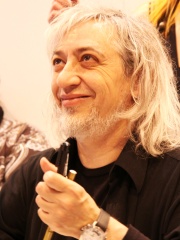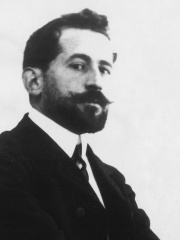

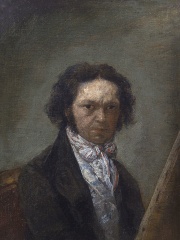

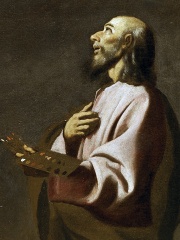

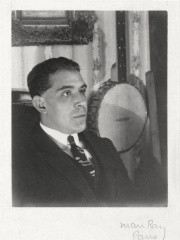

The Most Famous
PAINTERS from Spain
Top 10
The following people are considered by Pantheon to be the top 10 most legendary Spanish Painters of all time. This list of famous Spanish Painters is sorted by HPI (Historical Popularity Index), a metric that aggregates information on a biography's online popularity. Visit the rankings page to view the entire list of Spanish Painters.

1. Pablo Picasso (1881 - 1973)
With an HPI of 91.68, Pablo Picasso is the most famous Spanish Painter. His biography has been translated into 204 different languages on wikipedia.
Pablo Ruiz Picasso (25 October 1881 – 8 April 1973) was a Spanish painter, sculptor, printmaker, ceramicist, and theatre designer who spent most of his adult life in France. One of the most influential artists of the 20th century, he is known for co-founding the Cubist movement, the invention of constructed sculpture, the co-invention of collage, and for the wide variety of styles that he helped develop and explore. Among his most famous works are the proto-Cubist Les Demoiselles d'Avignon (1907) and the anti-war painting Guernica (1937), a dramatic portrayal of the bombing of Guernica by German and Italian air forces during the Spanish Civil War. Beginning his formal training under his father José Ruiz y Blasco aged seven, Picasso demonstrated extraordinary artistic talent from a young age, painting in a naturalistic manner through his childhood and adolescence. During the first decade of the 20th century, his style changed as he experimented with different theories, techniques, and ideas. After 1906, the Fauvist work of the older artist Henri Matisse motivated Picasso to explore more radical styles, beginning a fruitful rivalry between the two artists, who subsequently were often paired by critics as the leaders of modern art. Picasso's output, especially in his early career, is often periodized. While the names of many of his later periods are debated, the most commonly accepted periods in his work are the Blue Period (1901–1904), the Rose Period (1904–1906), the African-influenced Period (1907–1909), Analytic Cubism (1909–1912), and Synthetic Cubism (1912–1919), also referred to as the Crystal period. Much of Picasso's work of the late 1910s and early 1920s is in a neoclassical style, and his work in the mid-1920s often has characteristics of Surrealism. His later work often combines elements of his earlier styles. Exceptionally prolific throughout the course of his long life, Picasso achieved universal renown and immense fortune for his revolutionary artistic accomplishments, and became one of the best-known figures in 20th-century art.

2. Salvador Dalí (1904 - 1989)
With an HPI of 89.93, Salvador Dalí is the 2nd most famous Spanish Painter. His biography has been translated into 201 different languages.
Salvador Domingo Felipe Jacinto Dalí i Domènech, Marquess of Dalí de Púbol (11 May 1904 – 23 January 1989), known as Salvador Dalí, was a Spanish surrealist artist renowned for his technical skill, precise draftsmanship, and the striking and bizarre images in his work. Born in Figueres in Catalonia, Dalí received his formal education in fine arts in Madrid. Influenced by Impressionism and the Renaissance masters from a young age, he became increasingly attracted to Cubism and avant-garde movements. He moved closer to Surrealism in the late 1920s and joined the Surrealist group in 1929, soon becoming one of its leading exponents. His best-known work, The Persistence of Memory, was completed in August 1931. Dalí lived in France throughout the Spanish Civil War (1936 to 1939) before leaving for the United States in 1940 where he achieved commercial success. He returned to Spain in 1948 where he announced his return to the Catholic faith and developed his "nuclear mysticism" style, based on his interest in classicism, mysticism, and recent scientific developments. Dalí's artistic repertoire included painting, sculpture, film, graphic arts, animation, fashion, and photography, at times in collaboration with other artists. He also wrote fiction, poetry, autobiography, essays, and criticism. Major themes in his work include dreams, the subconscious, sexuality, religion, science and his closest personal relationships. To the dismay of those who held his work in high regard, and to the irritation of his critics, his eccentric and ostentatious public behavior often drew more attention than his artwork. His public support for the Francoist regime, his commercial activities and the quality and authenticity of some of his late works have also been controversial. His life and work were an important influence on other Surrealists, pop art, popular culture, and contemporary artists such as Jeff Koons and Damien Hirst. There are two major museums devoted to Salvador Dalí's work: the Dalí Theatre-Museum in Figueres, Spain, and the Salvador Dalí Museum in St. Petersburg, Florida, U.S.

3. Francisco Goya (1746 - 1828)
With an HPI of 87.42, Francisco Goya is the 3rd most famous Spanish Painter. His biography has been translated into 158 different languages.
Francisco José de Goya y Lucientes (; Spanish: [fɾanˈθisko xoˈse ðe ˈɣoʝa i luˈθjentes]; 30 March 1746 – 16 April 1828) was a Spanish romantic painter and printmaker. He is considered the most important Spanish artist of the late 18th and early 19th centuries. His paintings, drawings, and engravings reflected contemporary historical upheavals and influenced important 19th- and 20th-century painters. Goya is often referred to as the last of the Old Masters and the first of the moderns. Goya was born in Fuendetodos, Aragon to a middle-class family in 1746. He studied painting from age 14 under José Luzán y Martínez and moved to Madrid to study with Anton Raphael Mengs. He married Josefa Bayeu in 1773. Goya became a court painter to the Spanish Crown in 1786 and this early portion of his career is marked by portraits of the Spanish aristocracy and royalty, and Rococo-style tapestry cartoons designed for the royal palace. Although Goya's letters and writings survive, little is known about his thoughts. He had a severe and undiagnosed illness in 1793 that left him deaf, after which his work became progressively darker and more pessimistic. His later easel and mural paintings, prints and drawings appear to reflect a bleak outlook on personal, social, and political levels and contrast with his social climbing. He was appointed Director of the Royal Academy in 1795, the year Manuel Godoy made an unfavorable treaty with France. In 1799, Goya became Primer Pintor de Cámara (Prime Court Painter), the highest rank for a Spanish court painter. In the late 1790s, commissioned by Godoy, he completed his La maja desnuda, a remarkably daring nude for the time and clearly indebted to Diego Velázquez. In 1800–01, he painted Charles IV of Spain and His Family, also influenced by Velázquez. In 1807, Napoleon led the French army into the Peninsular War against Spain. Goya remained in Madrid during the war, which seems to have affected him deeply. Although he did not speak his thoughts in public, they can be inferred from his Disasters of War series of prints (although published 35 years after his death) and his 1814 paintings The Second of May 1808 and The Third of May 1808. Other works from his mid-period include the Caprichos and Los Disparates etching series, and a wide variety of paintings concerned with insanity, mental asylums, witches, fantastical creatures and religious and political corruption, all of which suggest that he feared for both his country's fate and his own mental and physical health. His late period culminates with the Black Paintings of 1819–1823, applied on oil on the plaster walls of his house the Quinta del Sordo (House of the Deaf Man) where, disillusioned by political and social developments in Spain, he lived in near isolation. Goya eventually abandoned Spain in 1824 to retire to the French city of Bordeaux, accompanied by his much younger maid and companion, Leocadia Weiss, who may have been his lover. There he completed his La Tauromaquia series and a number of other works. Following a stroke that left him paralyzed on his right side, Goya died and was buried on 16 April 1828 aged 82.

4. Diego Velázquez (1599 - 1660)
With an HPI of 86.97, Diego Velázquez is the 4th most famous Spanish Painter. His biography has been translated into 152 different languages.
Diego Rodríguez de Silva y Velázquez (baptised 6 June 1599 – 6 August 1660) was a Spanish painter, the leading artist in the court of King Philip IV of Spain and Portugal, and of the Spanish Golden Age. He is generally considered one of the greatest artists in the history of Western art. He was an individualistic artist of the Baroque period (c. 1600–1750). He began to paint in a precise tenebrist style, later developing a freer manner characterized by bold brushwork. In addition to numerous renditions of scenes of historical and cultural significance, he painted scores of portraits of the Spanish royal family and commoners, culminating in his masterpiece Las Meninas (1656). Velázquez's paintings became a model for 19th century realist and impressionist painters. In the 20th century, artists such as Pablo Picasso, Salvador Dalí, and Francis Bacon paid tribute to Velázquez by re-interpreting some of his most iconic images. Most of his work entered the Spanish royal collection, and by far the best collection is in the Museo del Prado in Madrid, although some portraits were sent abroad as diplomatic gifts, especially to the Austrian Habsburgs.

5. Joan Miró (1893 - 1983)
With an HPI of 82.90, Joan Miró is the 5th most famous Spanish Painter. His biography has been translated into 88 different languages.
Joan Miró i Ferrà ( mi-ROH, US also mee-ROH; Catalan: [ʒuˈan miˈɾoj fəˈra]; 20 April 1893 – 25 December 1983) was a Catalan painter, sculptor and ceramist from Spain. A museum dedicated to his work, the Fundació Joan Miró, was established in his native city of Barcelona in 1975, and another, the Fundació Pilar i Joan Miró, was established in his adoptive city of Palma, Mallorca in 1981. Earning international acclaim, his work has been interpreted as Surrealism but with a personal style, sometimes also veering into Fauvism and Expressionism. He was notable for his interest in the unconscious or the subconscious mind, reflected in his re-creation of the childlike. His difficult-to-classify works also had a manifestation of Catalan pride. In numerous interviews dating from the 1930s onwards, Miró expressed contempt for conventional painting methods as a way of supporting bourgeois society, and declared an "assassination of painting" in favour of upsetting the visual elements of established painting.

6. Francisco de Zurbarán (1598 - 1664)
With an HPI of 78.73, Francisco de Zurbarán is the 6th most famous Spanish Painter. His biography has been translated into 79 different languages.
Francisco de Zurbarán ( ZOOR-bə-RAHN, Spanish: [fɾanˈθisko ðe θuɾβaˈɾan]; baptized 7 November 1598 – 27 August 1664) was a Spanish painter. He is known primarily for his religious paintings depicting monks, nuns, and martyrs, and for his still-lifes. Zurbarán gained the nickname "Spanish Caravaggio", owing to the forceful use of chiaroscuro in which he excelled. He was the father of the painter Juan de Zurbarán.

7. Bartolomé Esteban Murillo (1617 - 1682)
With an HPI of 78.48, Bartolomé Esteban Murillo is the 7th most famous Spanish Painter. His biography has been translated into 75 different languages.
Bartolomé Esteban Murillo ( mure-IL-oh, m(y)uu-REE-oh, Spanish: [baɾtoloˈme esˈteβam muˈɾiʎo]; late December 1617, baptised 1 January 1618 – 3 April 1682) was a Spanish Baroque painter. Although he is best known for his religious works, Murillo also produced a considerable number of paintings of contemporary women and children. These lively realistic portraits of flower girls, street urchins, and beggars constitute an extensive record of the everyday life of his times. He also painted two self-portraits, one in the Frick Collection portraying him in his 30s, and one in London's National Gallery portraying him about 20 years later. In 2017–18, the two museums held an exhibition of them.

8. Juan Gris (1887 - 1927)
With an HPI of 75.25, Juan Gris is the 8th most famous Spanish Painter. His biography has been translated into 53 different languages.
José Victoriano González-Pérez (23 March 1887 – 11 May 1927), better known as Juan Gris (Spanish: [ˈxwaŋ ˈɡɾis]; French: [gʀi]), was a Spanish painter born in Madrid who lived and worked in France for most of his active period. Closely connected to the innovative artistic genre Cubism, his works are among the movement's most distinctive.

9. Joaquín Sorolla (1863 - 1923)
With an HPI of 71.73, Joaquín Sorolla is the 9th most famous Spanish Painter. His biography has been translated into 42 different languages.
Joaquín Sorolla y Bastida (27 February 1863 – 10 August 1923) was a Spanish painter. Sorolla excelled in the painting of portraits, landscapes, and monumental works of social and historical themes. His most typical works are characterized by a dexterous representation of the people and landscape under the bright sunlight of Spain and sunlit water.

10. Antoni Tàpies (1923 - 2012)
With an HPI of 70.02, Antoni Tàpies is the 10th most famous Spanish Painter. His biography has been translated into 38 different languages.
Antoni Tàpies i Puig, 1st Marquess of Tàpies (Catalan: [ənˈtɔni ˈtapi.əs]; 13 December 1923 – 6 February 2012) was a Catalan painter, sculptor, and art theorist.
People
Pantheon has 56 people classified as Spanish painters born between 1285 and 1954. Of these 56, 5 (8.93%) of them are still alive today. The most famous living Spanish painters include Antonio López García, Joaquín Sabina, and Antón Lamazares. The most famous deceased Spanish painters include Pablo Picasso, Salvador Dalí, and Francisco Goya.
Living Spanish Painters
Go to all RankingsAntonio López García
1936 - Present
HPI: 61.30
Joaquín Sabina
1949 - Present
HPI: 59.82
Antón Lamazares
1954 - Present
HPI: 58.40
Javier Mariscal
1950 - Present
HPI: 57.20
Luis Royo
1954 - Present
HPI: 56.99
Deceased Spanish Painters
Go to all RankingsPablo Picasso
1881 - 1973
HPI: 91.68
Salvador Dalí
1904 - 1989
HPI: 89.93
Francisco Goya
1746 - 1828
HPI: 87.42
Diego Velázquez
1599 - 1660
HPI: 86.97
Joan Miró
1893 - 1983
HPI: 82.90
Francisco de Zurbarán
1598 - 1664
HPI: 78.73
Bartolomé Esteban Murillo
1617 - 1682
HPI: 78.48
Juan Gris
1887 - 1927
HPI: 75.25
Joaquín Sorolla
1863 - 1923
HPI: 71.73
Antoni Tàpies
1923 - 2012
HPI: 70.02
Enrique Simonet
1866 - 1927
HPI: 66.71
Francisco Pacheco
1564 - 1644
HPI: 66.20
Overlapping Lives
Which Painters were alive at the same time? This visualization shows the lifespans of the 25 most globally memorable Painters since 1700.





